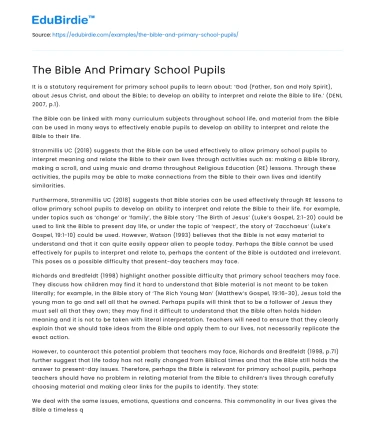It is a statutory requirement for primary school pupils to learn about: ‘God (Father, Son and Holy Spirit), about Jesus Christ, and about the Bible; to develop an ability to interpret and relate the Bible to life.’ (DENI, 2007, p.1).
The Bible can be linked with many curriculum subjects throughout school life, and material from the Bible can be used in many ways to effectively enable pupils to develop an ability to interpret and relate the Bible to their life.
Save your time!
We can take care of your essay
- Proper editing and formatting
- Free revision, title page, and bibliography
- Flexible prices and money-back guarantee
Stranmillis UC (2018) suggests that the Bible can be used effectively to allow primary school pupils to interpret meaning and relate the Bible to their own lives through activities such as: making a Bible library, making a scroll, and using music and drama throughout Religious Education (RE) lessons. Through these activities, the pupils may be able to make connections from the Bible to their own lives and identify similarities.
Furthermore, Stranmillis UC (2018) suggests that Bible stories can be used effectively through RE lessons to allow primary school pupils to develop an ability to interpret and relate the Bible to their life. For example, under topics such as ‘change’ or ‘family’, the Bible story ‘The Birth of Jesus’ (Luke’s Gospel, 2:1-20) could be used to link the Bible to present day life, or under the topic of ‘respect’, the story of ‘Zacchaeus’ (Luke’s Gospel, 19:1-10) could be used. However, Watson (1993) believes that the Bible is not easy material to understand and that it can quite easily appear alien to people today. Perhaps the Bible cannot be used effectively for pupils to interpret and relate to, perhaps the content of the Bible is outdated and irrelevant. This poses as a possible difficulty that present-day teachers may face.
Richards and Bredfeldt (1998) highlight another possible difficulty that primary school teachers may face. They discuss how children may find it hard to understand that Bible material is not meant to be taken literally; for example, in the Bible story of ‘The Rich Young Man’ (Matthew’s Gospel, 19:16-30), Jesus told the young man to go and sell all that he owned. Perhaps pupils will think that to be a follower of Jesus they must sell all that they own; they may find it difficult to understand that the Bible often holds hidden meaning and it is not to be taken with literal interpretation. Teachers will need to ensure that they clearly explain that we should take ideas from the Bible and apply them to our lives, not necessarily replicate the exact action.
However, to counteract this potential problem that teachers may face, Richards and Bredfeldt (1998, p.71) further suggest that life today has not really changed from Biblical times and that the Bible still holds the answer to present-day issues. Therefore, perhaps the Bible is relevant for primary school pupils, perhaps teachers should have no problem in relating material from the Bible to children’s lives through carefully choosing material and making clear links for the pupils to identify. They state:
We deal with the same issues, emotions, questions and concerns. This commonality in our lives gives the Bible a timeless quality of application.
In agreement, Doherty (1996) believes that Bible material can be taught to children to help them live in this difficult, contemporary world. He suggests a way that material from the Bible can be used effectively in primary school; he states: ‘Bible stories should be the vehicle for teaching Bible truths’. Bible stories should be used effectively to enable primary school pupils to interpret and relate the Bible to their present-day lives by allowing them to make connections and see similarities within the stories and their own lives.
However, in contradiction, Stranmillis UC (2018, p.23) state: ‘Biblical narratives shed light on how people thought and behaved in those times, they do not necessarily have a “meaning” for today’. If the Bible has no “meaning” in today’s society, perhaps this is a potential difficulty that teachers may face.
Doherty (1996) suggests a way that the Bible can be made attractive to children and taught in a simple way, he suggests that teachers could use illustrations from the Bible within lessons or use religious songs and Bible verses to portray Bible stories and meaning. These are methods in which the Bible can be used effectively to ensure primary school pupils can interpret and relate the Bible to their lives.
To conclude, evidently there are many ways in which the Bible can be used effectively to allow primary school pupils to develop an ability to interpret and relate the Bible to life. Primary school teachers must overcome the potential difficulties they face by ensuring that the Bible material they are using in their lessons is relevant, engaging and easily understood so that pupils can interpret and relate the Bible to their lives today.
References
- Department of Education. (2007) Core Syllabus for Religious Education, available at: https://www.education-ni.gov.uk/sites/default/files/publications/de/religious-education-core-syllabus-english-version.pdf (accessed on 29/04/2020).
- Doherty, S. (1996) How to Teach Bible Doctrines to Children, Lisburn, Child Evangelism Fellowship, available at: https://www.teachkids.eu/pdfs/how_doctrine.pdf, accessed (28.04.2020).
- Luke’s Gospel, 2:1-20 The Birth of Jesus and 19:1-10 The Story of Zacchaeus, The New Testament, The Holy Bible.
- Matthew’s Gospel, 19:16-30, The Rich Young Man, The New Testament, The Holy Bible.
- Richards, L. and Bredfeldt, J. (1998) Creative Bible Teaching, Chicago, Moody Publishers, available at: https://books.google.co.uk/books?hl=en&lr=&id=Q9ny1fVppAEC&oi=fnd&pg=PA7&dq=difficulties+teachers+face+teaching+with+the+Bible&ots=M92AxeJvfP&sig=3gzBU3q3yGHOAKM5ipaGGqayFa8&redir_esc=y#v=onepage&q=difficulties%20teachers%20face%20teaching%20with%20the%20Bible&f=true, accessed (28.04.2020).
- Stranmillis UC (2018) Teaching Religious Education in the Primary School: An Inclusive Approach (Religious Education Handbook Year 1), Belfast, Stranmillis University College.
- Watson, B. (1993) The Effective Teaching of Religious Education, Harlow, Pearson Education Limited.






 Stuck on your essay?
Stuck on your essay?

